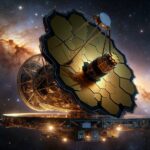The day before the asteroid known as 2008 OS7 approached Earth, NASA’s powerful Goldstone Solar System Radar captured its first detailed images. NASA’s Jet Propulsion Laboratory (JPL) capitalized on this opportunity to study the object extensively. This stadium-sized asteroid, which posed no collision danger, revealed its characteristics thanks to the close observation, despite having previously been too distant for such detailed imaging.
Discovery and Radar Imaging
Initially discovered in 2008 by the Catalina Sky Survey funded by NASA, 2008 OS7 was identified as a near-Earth object (NEO) with a diameter estimated between 650 to 1,640 feet. It was found to be a slow rotator, taking about 29.5 hours for one full turn. The asteroid’s rotational period was ascertained by the Astronomical Institute of the Czech Academy of Sciences, using brightness variations due to its spinning.
Detailed Surface Features Uncovered
During its close approach on February 2, the JPL team employed the 230-foot Goldstone Solar System Radar to examine the NEO’s size, shape, and surface. The radar disclosed a smaller-than-anticipated asteroid with a diameter of 500 to 650 feet, featuring a varied landscape of rounded and angular regions, and confirmed its unusual rotational pace.
Path Calculation and Impact Hazard Assessment
The radar observations were crucial for NASA’s Center for Near Earth Object Studies (CNEOS) to refine the asteroid’s orbital path around the Sun. 2008 OS7 is classified as a potentially hazardous asteroid due to its size and proximity to Earth’s orbit, yet the recent approach will be its closest for at least 200 years. NASA is focused on detecting NEOs larger than 460 feet, which pose significant impact risks.
The dedicated work at Goldstone Radar Group and CNEOS is a part of NASA’s Near-Earth Object Observations Program, which falls under the Planetary Defense Coordination Office. These efforts are critical for monitoring NEOs and safeguarding our planet from potential collisions.
With the close observation of 2008 OS7, NASA continues to monitor and study NEOs to better understand their paths and characteristics—which is vital for our planet’s defense strategy.










